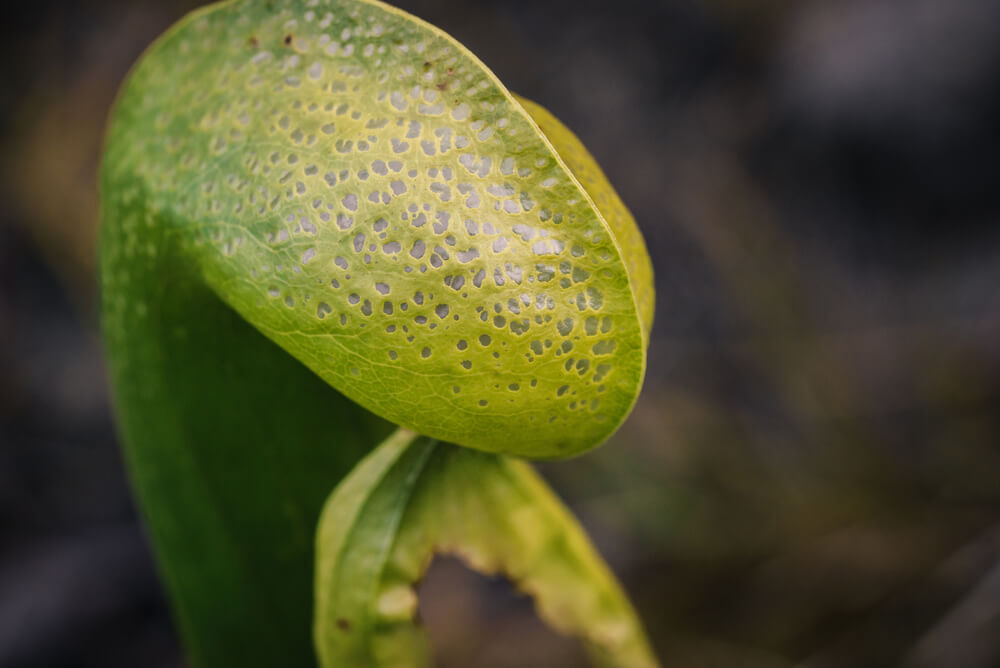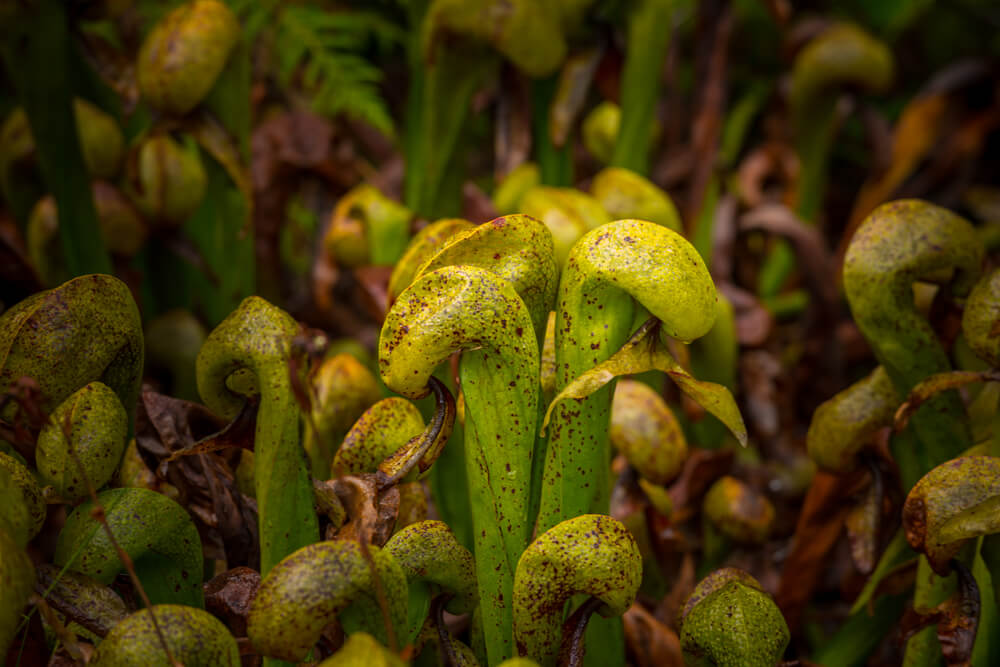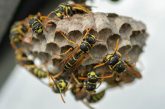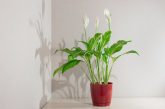
The Cobra Lily, scientifically known as Darlingtonia californica, is a fascinating member of the carnivorous plant family, captivating botanists and plant enthusiasts alike with its unique appearance and intriguing feeding mechanisms. Native to the nutrient-poor bogs and fens of Northern California and Oregon, this remarkable plant has adapted to thrive in environments where other plants struggle.
One of the most striking features of the Cobra Lily is its distinct resemblance to a rearing cobra, complete with a hood-like structure that curves gracefully over its tubular leaves. This adaptation is not just for show; it plays a crucial role in the plant’s survival strategy. The hooded leaves are equipped with translucent patches that confuse prey by allowing light to filter through in unexpected ways. Unsuspecting insects are lured into these tube-like structures by nectar glands situated around the openings.
Once inside, escape becomes nearly impossible due to downward-pointing hairs that guide them deeper into the trap where digestive enzymes break down their bodies for absorption. Unlike many other carnivorous plants, Darlingtonia californica does not rely on closing traps but uses this passive mechanism to secure its meals.
The Cobra Lily thrives in cool water conditions provided by mountain streams or seepage areas, requiring precise environmental conditions that make it both rare and challenging to cultivate outside its natural habitat. As such, it remains an object of fascination for those interested in botany and ecology.
Understanding these unique adaptations provides insight into how diverse life can be even within specific niches like carnivorous plants. The Cobra Lily exemplifies nature’s ingenuity in evolving specialized strategies for survival amidst challenging circumstances.
The Toxicity of Cobra Lily

Cobra lilies, with their striking appearance and unique structure, often capture the interest of plant enthusiasts. However, it’s crucial to understand the potential risks associated with these fascinating plants. One common question that arises is: “Is cobra lily toxic?” The answer is yes, cobra lilies are indeed considered toxic.
As a member of the poisonous plants category, cobra lily toxicity can pose safety concerns for both humans and animals. The plant contains compounds that can cause irritation or more severe reactions if ingested or if there is prolonged skin contact. Therefore, it’s important to handle cobra lilies with care and to ensure they are kept out of reach of pets and small children who might be tempted to touch or taste them.
For those who enjoy cultivating exotic plants like the cobra lily, taking appropriate precautions can help mitigate any potential hazards. Wearing gloves while handling the plant and washing hands thoroughly afterward are simple yet effective measures to enhance plant safety in your home or garden environment. By being informed about the toxicity of cobra lilies and other similar species, you can enjoy their beauty without compromising on safety.
Effects of Cobra Lily on Humans and Animals
The Cobra Lily, scientifically known as Darlingtonia californica, is a fascinating carnivorous plant that captivates many with its unique appearance. However, it’s important to be informed about the potential risks it poses to both humans and animals. While the Cobra Lily itself is not highly toxic, caution should still be exercised.
For humans, direct contact with the plant typically doesn’t result in severe reactions. However, it’s advisable to wash hands after handling it to avoid any mild skin irritation or allergic reactions. When it comes to pets, particularly curious cats and dogs that may nibble on plants, the effects can be more concerning. Although not among the most toxic plants for pets, ingestion could lead to plant poisoning symptoms such as vomiting or gastrointestinal upset.
Ensuring human safety around cobra lilies involves placing them out of reach of children and pets and educating family members about their potential effects. Pet owners should remain vigilant in keeping these intriguing yet potentially hazardous plants away from their furry friends’ reach to prevent any adverse effects on pets’ health. As with any plant considered toxic for pets, consulting a veterinarian if ingestion occurs is always a prudent step.
Cobra Lily in the Ecosystem
The cobra lily, a fascinating carnivorous plant, plays a significant ecological role within its native habitats. Known for its striking appearance and unique adaptations, the cobra lily contributes to the ecosystem in several important ways. One of its primary roles is maintaining insect populations. By preying on various insects, it helps control their numbers, ensuring that no single species dominates and disrupts the ecological balance.
In addition to regulating insect populations, the cobra lily offers benefits that extend beyond its immediate environment. As a carnivorous plant, it thrives in nutrient-poor soils where other plants might struggle to survive. This ability allows it to occupy niches that are often devoid of other vegetation, thereby contributing to biodiversity and providing habitat for various organisms.
However, it’s important to consider the environmental impact of toxic plants like the cobra lily as well. While their toxins can deter herbivores and reduce competition from other plants, they must be balanced within their ecosystems to avoid negative consequences. The presence of such plants can influence soil chemistry and affect nearby flora and fauna.
Overall, the ecological role of cobra lilies underscores their importance in maintaining healthy ecosystems. By controlling insect populations and occupying unique niches within their habitats, these remarkable plants highlight the complex interplay between species that sustains biodiversity in our natural world.
Safety Tips for Handling Cobra Lilies at Home or in Gardens
When cultivating cobra lilies in your home or garden, it’s essential to prioritize safety due to their toxic nature. Understanding the necessary safety measures for toxic plants can help you enjoy these fascinating carnivorous plants without risk.
First and foremost, always wear gloves when handling cobra lilies. This simple precaution helps prevent skin irritation or accidental ingestion of plant sap. Additionally, ensure that children and pets are kept away from these plants, as their curiosity could lead to harmful exposure.
When gardening with poisonous plants like the cobra lily, it’s crucial to label them clearly. This not only serves as a reminder for yourself but also warns visitors who might not be familiar with the plant’s potential dangers. Furthermore, if you need to prune or repot your cobra lilies, use dedicated tools that are thoroughly cleaned after each use to avoid cross-contamination with other garden plants.
Incorporating these safety practices into your gardening routine allows you to handle carnivorous plants safely while appreciating their unique beauty and ecological role in your garden ecosystem.
Weighing the Risks and Benefits of Growing Cobra Lilies
Growing cobra lilies can be a rewarding endeavor for gardeners interested in cultivating unique and exotic plants. However, it’s essential to weigh the risks and benefits before deciding to add these captivating carnivorous plants to your collection.
One of the primary benefits of growing cobra lilies is their striking appearance. With their snake-like hooded leaves and intricate patterns, they serve as a fascinating focal point in any garden or terrarium. Additionally, as carnivorous plants, they help control insect populations by trapping and digesting small prey, making them an eco-friendly pest management option.
On the other hand, cultivating cobra lilies comes with its challenges. They require specific growing conditions to thrive, including cool temperatures, high humidity levels, and pure water sources free from minerals. These requirements can make them difficult to maintain for novice gardeners or those living in warmer climates.
Furthermore, while cobra lilies are relatively pest-resistant due to their carnivorous nature, they are not immune to issues such as root rot if overwatered or exposed to stagnant conditions. Therefore, careful monitoring and maintenance are necessary to ensure their health.
In conclusion, while growing cobra lilies can be a fulfilling horticultural project that adds beauty and biodiversity to your space, it’s crucial to consider whether you can meet their unique care needs before embarking on this botanical journey. By weighing these risks against the benefits they offer, you can make an informed decision about whether these remarkable plants are right for your garden or indoor collection.



